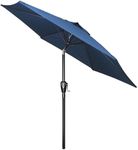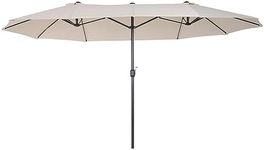Buying Guide for the Best Patio Umbrellas
Choosing the right patio umbrella can make your outdoor space much more comfortable and enjoyable. The best umbrella for you will depend on your space, how much shade you need, and how you plan to use it. By understanding the key features and specifications, you can find an umbrella that fits your needs and lasts for many seasons.Size (Diameter or Length)The size of a patio umbrella refers to the width of the canopy when it is fully open. This is important because it determines how much shade the umbrella will provide. Smaller umbrellas (around 6-7 feet) are suitable for small tables or compact spaces, while medium sizes (8-10 feet) work well for standard patio tables or seating areas. Large umbrellas (11 feet and above) are best for big dining sets or larger lounging areas. To pick the right size, consider the area you want to shade and make sure the umbrella is at least 2 feet wider than the space or table you want to cover.
Canopy MaterialThe canopy material is the fabric that provides the shade. This is important because it affects durability, colorfastness, and protection from the sun. Common materials include polyester, olefin, and acrylic. Polyester is affordable and resists fading moderately well, olefin is more durable and resists moisture, while acrylic (like Sunbrella) offers the best fade resistance and UV protection. If you want an umbrella that lasts longer and keeps its color, look for higher-quality materials, especially if your umbrella will be in direct sun for long periods.
Frame MaterialThe frame is what supports the umbrella and can be made from materials like aluminum, wood, or steel. Aluminum is lightweight, rust-resistant, and easy to move, making it a popular choice for most users. Wood frames offer a classic look but may require more maintenance and are heavier. Steel frames are strong but can rust if not properly coated. Choose a frame material based on your climate (wet or dry), how much maintenance you want to do, and the style you prefer.
Opening MechanismThe opening mechanism is how you open and close the umbrella. Common types include manual push-up, crank lift, and pulley systems. Crank lifts are the easiest to use, especially for larger umbrellas, while push-up mechanisms are simple but may require more effort. Pulley systems are often found on wooden umbrellas. If you want convenience, especially if you’ll open and close the umbrella often, a crank lift is usually the best choice.
Tilt FunctionA tilt function allows you to angle the umbrella canopy to block the sun as it moves throughout the day. Some umbrellas have a simple push-button tilt, while others offer more advanced mechanisms like auto-tilt or rotational tilt. If your patio gets sun from different directions or you want to maximize shade at all times, a tilt feature is very useful. If your umbrella will stay in one position or you only use it at certain times, a fixed canopy may be sufficient.
Base CompatibilityThe base is what keeps your umbrella stable and upright. Not all umbrellas come with a base, and the size and weight needed depend on the umbrella’s size and where it will be used. Heavier and larger umbrellas need sturdier, heavier bases. If your umbrella will be exposed to wind or is freestanding (not through a table), make sure to choose a base that matches the recommended weight for your umbrella’s size. This ensures safety and prevents tipping.















